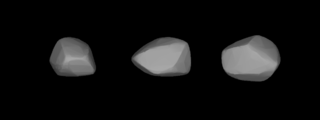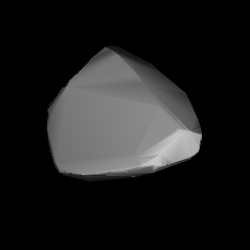
120 Lachesis is a large main-belt asteroid. It was discovered by French astronomer Alphonse Borrelly on April 10, 1872, and independently by German-American astronomer Christian Heinrich Friedrich Peters on April 11, 1872, then named after Lachesis, one of the Moirai, or Fates, in Greek mythology. A Lachesean occultation of a star occurred in 1999 and was confirmed visually by five observers and once photoelectrically, with the chords yielding an estimated elliptical cross-section of 184 × 144 km.

295 Theresia is a typical Main belt asteroid. It was discovered by Johann Palisa on 17 August 1890 in Vienna.

312 Pierretta is a 46 km main-belt asteroid discovered on 28 Aug 1891 by Auguste Charlois at Nice.

347 Pariana is a metallic background asteroid from the central region of the asteroid belt. It was discovered by French astronomer Auguste Charlois at the Nice Observatory on 28 November 1892. The M-type asteroid has a short rotation period of 4.1 hours and measures approximately 49 kilometers in diameter. The origin of the asteroid's name remains unknown.

373 Melusina is a large Main belt asteroid. It is classified as a C-type asteroid and is probably composed of carbonaceous material. It was discovered by Auguste Charlois on 15 September 1893 in Nice.

378 Holmia is a typical Main belt asteroid.

383 Janina is a Themistian asteroid, approximately 46 kilometers in diameter. It is spectral B-type and is probably composed of primitive carbonaceous chondritic material.

392 Wilhelmina is a large Main belt asteroid.

403 Cyane is a typical Main belt asteroid.

417 Suevia is a typical Main belt asteroid. It is classified as a K-type/S-type asteroid.
501 Urhixidur is a relatively large main belt asteroid. It was discovered on 18 January 1903, by astronomer Max Wolf (1863–1932), at the Heidelberg Observatory in southwest Germany. Like 500 Selinur and 502 Sigune, it is named after a character in Friedrich Theodor Vischer's then-bestseller satirical novel Auch Einer.
476 Hedwig is a main-belt asteroid discovered on August 17, 1901, by Luigi Carnera at Heidelberg. Named in honour of the wife of Swedish-Danish astronomer Elis Strömgren.

499 Venusia is an asteroid in the outer asteroid belt, discovered by Max Wolf in 1902. Its diameter is 81 km. It is a dark P-type asteroid. It has an average distance from the Sun of 4 AU (600 million km).
500 Selinur is a minor planet, specifically an asteroid orbiting in the asteroid belt. Like 501 Urhixidur and 502 Sigune, it is named after a character in Friedrich Theodor Vischer's then-bestseller satirical novel Auch Einer.

502 Sigune is a minor planet, specifically an asteroid orbiting primarily in the asteroid belt. Like 501 Urhixidur and 500 Selinur, it is named after a character in Friedrich Theodor Vischer's then-bestseller satirical novel Auch Einer.

540 Rosamunde is an S-type asteroid belonging to the Flora family in the Main Belt. Its diameter is about 19 km and it has an albedo of 0.243 . Its rotation period is 9.336 hours.
545 Messalina is a minor planet, specifically an asteroid orbiting primarily in the asteroid belt. It was discovered on 3 October 1904 by Paul Götz, at Heidelberg. It is named after Valeria Messalina, the third wife of Roman Emperor Claudius.
563 Suleika is a minor planet orbiting the Sun. Previously designated as 1905 QK, it was discovered by German astronomer Paul Götz on 6 April 1905 from Heidelberg, Germany.

643 Scheherezade is a minor planet orbiting the Sun. It was named after the fictional storyteller Sheherazad.

875 Nymphe is a minor planet orbiting the Sun. It is a member of the Maria family of asteroids.















